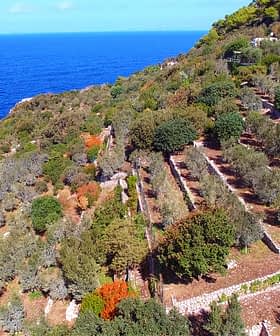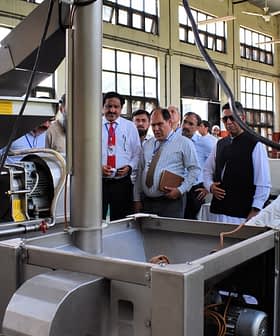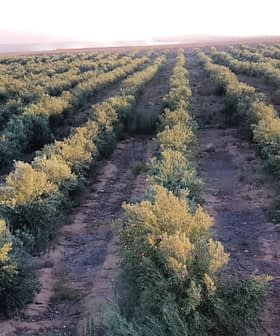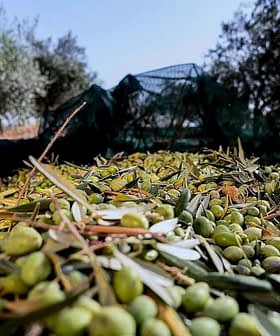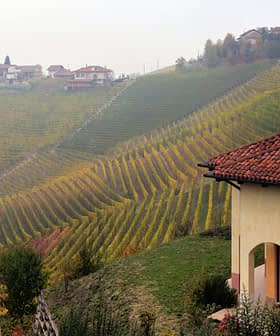Italian Farmers, Producers Confirm Production Rebound
Olive oil production for the 2023/24 crop year was bolstered by strong harvests in the south.
 (Photo: Masseria dei Nunzi)
(Photo: Masseria dei Nunzi) According to the latest update from the European Commission, Italian olive oil production is expected to reach 324,000 tons in the 2023/24 crop year.
Due to poor harvests in Spain and Greece, Italy is anticipated to produce one-third of Europe’s olive oil this year. Furthermore, an estimated 75 percent of the country’s production meets the extra virgin olive oil grade.
The commission figures also confirm expectations that Italian producers reported to Olive Oil Times in October, just as the harvest was underway.
See Also:2023 Harvest UpdatesThe fruitful harvest will also replenish olive oil stocks in the country. According to the Italian Ministry of Agriculture, Food Sovereignty and Forests, Italian extra virgin olive oil storage is now more than 200,000 tons, far exceeding the 96,000 tons reported in October.
Overall, Italian stocks of all grades of olive oil reached 269,574 tons at the end of January, a 14 percent increase from December 2023. Organic olive oil stocks account for 40,552 tons. Still, olive oil stocks remain 14.5 percent lower than at the same period of the previous year.
While olive oil production reached the previous decade’s average in 2023/24, yields varied enormously among regions.
Excessive rainfall and extreme weather events, such as repeated heatwaves, diminished production in much of central and northern Italy, with the southern regions faring much better.
In the northern region of Lombardy, growers faced some of the harshest climatic conditions.
“We did not have anything to harvest,” Paul Willan, owner of Roveglio, told Olive Oil Times. “We lost the whole production because of three devastating hailstorms. No production on more than 1,000 olive trees.”
Those extreme events were felt both in the country and in the cities. “In Como, a city [not far from Roveglio’s farm], the hail was so large that it broke glass and damaged photovoltaic panels,” Willan said.
“On top of that, hailstorms brought infections from Pseudomonas savastanoi, which is spreading across the whole area,” he added about the bacterium responsible for the olive knot disease.
In the northeastern region of Veneto, olive oil yields are reported to be slightly better than elsewhere in northern Italy.
“We had a normal harvest this year, and we are very happy with the quality,” Johannes Pan, marketing manager of Paneolio, told Olive Oil Times. “The volume was normal compared to previous years.”
However, he warned that the enduring drought experienced in the region means olive oil production has “become more and more difficult every year. The effort required to achieve good results is becoming ever greater.”
“It is becoming increasingly difficult to rely on weather forecasts, and without technical support, many things in agriculture would probably no longer be possible as they were ten years ago,” Pan added.
On the opposite side of northern Italy, growers in Liguria, known for their Taggiasca olives, also lamented the effects of the ongoing dry climate.
“Due to drought, the olive harvest was disastrous in terms of volume,” Nicola Ferrarese, the co-owner of Tèra de Prie, told Olive Oil Times. “Thanks to some late rainfall, though, the quality is extraordinary.”
“The significant bitter note linked to a dry-condition defect from last year gave way to a spectacular Taggiasca,” he added.
Other significant central Italian olive oil-producing regions, such as Umbria, Tuscany and Lazio, reported mixed results.
“The harvest was not good for quality and volumes, which dropped about 40 percent compared to last year,” Massimo Romiti, owner of the Umbrian producer La Madonnuccia, told Olive Oil Times.
“At the beginning of October, we started harvesting following our procedures to ensure the best quality,” he added. “Still, the resulting extra virgin olive oil was poor in aromas and scents, so I decided to stop harvesting.”
Romiti said olive volumes were negatively impacted by rain in May, which delayed flowering.
“After that, the drought set in, and finally, with the August rain, the olive fruit fly appeared,” he said, adding that the farm is now heavily investing in organic production and improved pruning operations.
Meanwhile, producers in neighboring Lazio also reported uneven results.
“The harvest did not go well in terms of volumes. We have seen a 60 to 70 percent drop,” Antonio Gioacchini, owner of Olio Solum, told Olive Oil Times. “Quality, on the other hand, is top-notch.”
According to Gioacchini, rainfall heavily hit the “beautiful” flowering at the beginning of the season, which compromised the yields between May and June.
Conversely, Pietro Re, the founder and chief executive of nearby Olio Tamia, reported a 30 percent volume increase compared to the previous year.
“That is a very positive trend, considering the challenges we face in our region, where a significant reduction in production has been reported,” he told Olive Oil Times. “While our [processing] yields are down 1.5 percent compared to last year’s, quality stays very high.”
As the largest volumes of Italian olive oil – by a wide margin – are produced in the south of the country, the results from these regions significantly affect overall national figures.
Still, even in southern regions, producers had to cope with some extreme weather events.
Giovanni Petrazzuoli, a producer located in the hills of Caiazzo, Campania, told Olive Oil Times that excess rainfall during flowering impacted pollination.
“Production volumes this season dropped 30 percent because of the continuous rain in that period,” he said. “We are increasingly noticing climate change impacts.”
“We are going to have other seasons like the last one, or even worse, so we have to be resilient and manage our olive orchards in innovative ways,” Petrazzuoli added.
Meanwhile, Barbara Bibbò, owner of nearby Masseria dei Nunzi, emphasized how inclement weather might impact quality.
“We were a few weeks away from the harvest with an excellent quantity of olives on the trees,” she told Olive Oil Times. “A strong hailstorm in September seriously compromised our cultivation of the monovarietal Ortice-San Giorgio, native to our region. Therefore, we decided not to produce the monovarietal this year.”
“However, we have obtained an excellent blend, our Terra Oleum, with the other varieties on the company’s lands,” she added.
In Sicily, a few regions on the island are reporting a lower-than-expected harvest.
“First indications tell us that the overall Sicilian olive oil production will be five to 20 percent lower,” Salvatore Bono, co-owner of Bonolio, told Olive Oil Times. “Our volumes will be on par with last year as we anticipated such a downward turn and proceeded to some strategic acquisitions to improve our olive oil sources.”
Local farmers warned of lower volumes in Agrigento, Sicily while reporting high-quality yields.
“The olive harvest was more laborious and challenging than usual,” Silvia Di Vincenzo, co-owner of Mandranova, told Olive Oil Times. “A very hot year, it has been crucial to irrigate. The fruit ripening was slower and uneven across varieties. Still, we made it.”
“The product quality is good, which is due to the fact that we followed our grove every day, allowing us to achieve a high level of quality,” she added. “Volumes are below average.”
Puglia is usually responsible for 50 to 60 percent of national production on the mainland, making it Italy’s largest olive oil-producing region. Apulian producers mainly reported having a good harvest.
“It was a crazy harvest,” Lucia Di Molfetta, co-owner of Di Molfetta Pantaleo in Bisceglie, one of the most productive areas in Puglia, told Olive Oil Times. “We recently finished production last week, but the purchase price of olives this year was significant.”
She added that despite the mill’s policy of only purchasing fruit in the best conditions to produce its extra virgin olive oil, there was no shortage of opportunity this year. “We had relevant production volumes and excellent quality,” Di Molfetta said.
However, she warned that high olive oil prices had lowered the margin between high and low-quality producers, incentivizing some to save on production costs while taking advantage of high prices for virgin and lampante olive oil.
“Unluckily, nowadays, the difference between us, who work on quality, and those who do not, holds the same value in the market because prices have become so high that we can hardly afford to increase our prices further compared to large retail chains,” Di Molfetta concluded.


